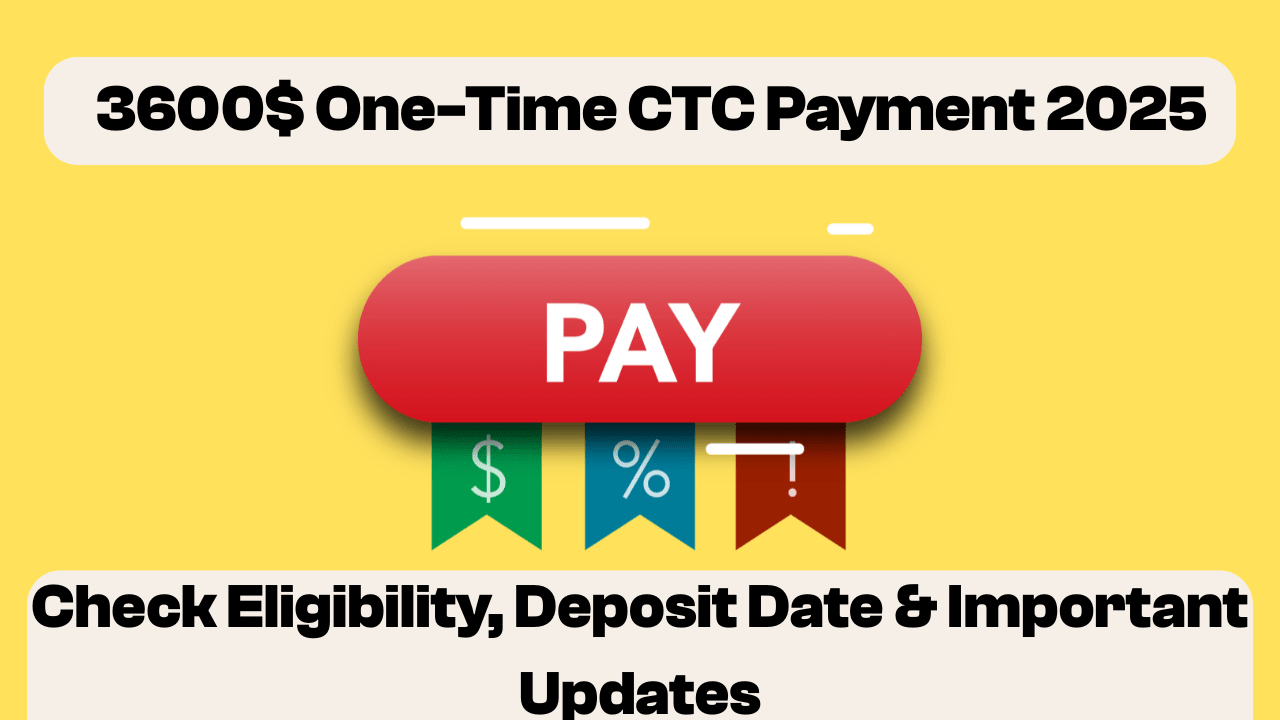The $3,600 Child Tax Credit (CTC) was part of the 2021 American Rescue Plan, offering $3,600 per child under 6 and $3,000 for ages 6–17, paid via monthly advances and tax refunds. That enhanced benefit ended in December 2021 in 2025, the CTC reverted to its standard form: up to $2,000 per child and a maximum refundable portion of $1,700. No one-time $3,600 payments are scheduled. Eligibility still depends on filing a tax return, having qualifying children under 17, and staying within income limits.
How the Child Tax Credit (CTC) works?
The Child Tax Credit (CTC) is a U.S. federal tax benefit designed to help families with the cost of raising children. For the 2024 tax year, eligible families can claim up to $2,000 per qualifying child under age 17. Of this amount, up to $1,700 may be refundable as the Additional Child Tax Credit if the family owes less in taxes than the credit amount. To qualify, the child must meet age, relationship, residency, and dependent status requirements. Income limits apply, and the credit phases out for higher earners. Families must file a tax return to receive the benefit.
CRA Deposit June Alert: $519, $680 & $179 GST/HST Rebates
Centrelink Job Seekers Payment June 2025
Canada Grocery Rebate 2025- Is it coming in 2025 Fact Check?
Expanded $3,000 or $3,600 tax credit: Here’s who qualifies
Under the American Rescue Plan Act (ARP), families received up to $3,600 per child under age 6 and $3,000 for children ages 6–17, fully refundable and partly disbursed monthly. Eligibility required a valid Social Security Number, U.S. citizenship or residency, and the child living with the taxpayer for over half the year. Income limits allowed full credit for single filers earning ≤ $75,000, heads of household ≤ $112,500, and married filing jointly ≤ $150,000—the amount phased out above those thresholds. No advance credit exists for 2025.
Monthly payment or full year-end credit: How would those payments work?
The Child Tax Credit (CTC) can be delivered in two ways: monthly payments or a lump sum at tax time. In 2021, eligible families received advance monthly payments—up to half the total credit—between July and December. The remaining amount was claimed when filing taxes, the following year. This gave families quicker financial relief. For tax years without advance payments, the full credit—up to $2,000 per child—is claimed at year-end as part of the tax return. Refundable portions, like the Additional Child Tax Credit, help families receive money even if they owe little or no tax.
Key dates for the 2025 Child Tax Credit (CTC) payment timeline
| Date | Event |
| January 1, 2025 | Beginning of the 2025 tax year—start tracking dependent-related info |
| January 31, 2025 | Employers must issue W‑2s to employees |
| January 27, 2025 | IRS begins accepting 2024 tax returns for the 2025 filing season |
| February 15, 2025 | Earliest date the IRS can begin issuing refunds that claim the ACTC (due to the PATH Act) |
| Late February–Early March 2025 | First wave of direct-deposit refunds sent to those who e-filed early and claimed CTC/ACTC |
| April 15, 2025 | Final deadline to file 2024 tax returns (without extension) |
| October 15, 2025 | Extended deadline for tax-filers who filed for an extension |
| December 31, 2025 | Last day to confirm children’s age and residency for eligibility |
Summary
- Refunds won’t begin before Feb 15 due to IRS anti-fraud laws.
- Early e-filers with direct deposit typically get CTC/ACTC refunds by late February to early March.
- Paper filers may experience additional delays—often March into April.
- File by April 15 (or October 15 with extension) to claim credit for 2025.
How soon will you get a payment?
- Advance Monthly Payments (2021–ended Dec 2021)
- Payments began mid-July 2021, typically around the 15th of each month (July through December), with $300 per child under 6 or $250 per child 6–17.
- Families automatically received payments based on prior-year tax returns, without needing to apply.
- Lump-Sum at Year-End (2022 onward)
- Without monthly advances, the CTC is claimed when you file your tax return.
- The IRS typically processes returns in late January, but due to the PATH Act, refunds including credits like CTC aren’t released until mid-February.
- In practice, early filers receive refunds in late February, around the 3rd–4th week.
- Summary Timing
- Monthly advance payments (when available): Around the 15th each month.
- Annual lump-sum refunds: Late February, for CTC claimed at tax time.
- To Receive Payments Promptly
- File early (once W‑2s/1099s are ready).
- Provide direct deposit details on your return.
- Be aware: if you’re claiming Additional or Advance CTC, the IRS won’t release those funds until after mid-February.
Eligibility criteria for the Child Tax Credit (CTC)
| Eligibility Criteria | Requirements |
| Child’s Age | Must be under 17 at the end of the tax year |
| Relationship | Must be your biological child, stepchild, adopted child, sibling, or descendant |
| Residency | Child must live with you for over half the year in the U.S. |
| Dependent Status | Must be claimed as a dependent on your tax return |
| Citizenship | Child must have a valid Social Security Number and be a U.S. citizen or resident |
| Income Limits | Full credit: up to $200,000 (single) or $400,000 (married filing jointly); phases out above |
| Tax Filing | You must file a federal tax return with qualifying children listed |
Fact Check Final Verdict:
The expanded $3,600 Child Tax Credit (CTC) was a temporary 2021 benefit under the American Rescue Plan, offering increased support through monthly payments and year-end credits. That enhanced credit ended in December 2021, and for 2025, the CTC returns to a maximum of $2,000 per child, with $1,700 refundable. No new $3,600 payments are planned. To qualify, families must meet specific criteria regarding income, residency, and child eligibility, and file a federal tax return. Payments are now received as a lump sum during tax season, typically by late February for early filers with direct deposit set up.








